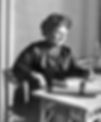
"The goal of early childhood education should be to activate the child's own natural desire to learn"
Maria Montessori
Montessori Teaching.
At Little Cakes, we all believe that Montessori teaching is one of the most important early years teaching practices of the last century. It continues to evolve and educate people across the world.
Dr Maria Montessori developed this highly effective method of teaching where children learn best by 'doing'. And happy self-motivated learners form positive images of themselves and become confident, successful people. She created specially designed resources to foster independence and a love for learning from an early age.
Montessori at School:
-
Freedom to choose
-
Hands-on learning and collaborative play
-
Follow the child's lead
Montessori Children:
-
Are free to express themselves
-
Have a sense of responsibility and self-discipline
-
Learn at their own pace
Who was Maria Montessori?
Born on 31 August 1870, in the town of Chiaravalle, Italy, she was one of the first women to attend medical school in Italy. She was encouraged by her parents to take up teaching, however, Maria had other plans. She enrolled in classes at an all-boys technical school with hopes of becoming an engineer but soon had a change of heart.
In 1890 Montessori enrolled at the University of Rome to study physics, mathematics, and natural sciences, receiving her diploma two years later. This enabled her to enter the Faculty of Medicine, as one of the first women in Italy, and the first to study at the University of Rome. Montessori stood out not just because of her gender, but because she was actually intent on mastering the subject matter. She won a series of scholarships at medical school which, together with the money she earned through private tuition, enabled her to pay for most of her medical education.
As her education progressed, she began to break through the barriers which constrained women’s careers and on 10 July 1896 became one of the first female doctors in Italy, and with this distinction also became known across the country.


She initially worked as a surgical assistant, much of her work was with the poor and in particular, children. As part of her work, she would regularly visit asylums for the children with mental disorders (as they were called in those days), seeking patients for treatment at the clinic.
It was her work with these children where she advocated the theory that the lack of adequate provision for children with mental and emotional disorders was a cause of most of their behaviour. She understood that teachers working with special needs children needed specific training.
This spurred her on to read all she could on the subject of children with learning differences. In particular, she studied the groundbreaking work of two early 19th century Frenchmen, Jean-Marc Itard and Edouard Séguin, his student.
Séguin realised that each child is an individual. He created practical apparatus and equipment to help develop the sensory perceptions and motor skills of intellectually challenged children, which Montessori was later to use in new ways.
Maria also was appointed co-director of a new institution called the Orthophrenic School. The school took children with a broad spectrum of disorders. It was here where she become more of an educator rather than a medical doctor.
In 1901 Montessori left the Orthophrenic School and immersed herself in her own studies of educational philosophy and anthropology. In 1904 she took up a post as a lecturer at the Pedagogic School of the University of Rome, which she held until 1908.
Maria was given the opportunity to occupy a group of typical children (whose parents where out working all day). She established her first Casa dei Bambini or ‘Children’s House’, which opened on 6 January 1907. She put many different activities and other materials into the children’s environment but kept only those that engaged them. What Montessori came to realise was that children who were placed in an environment where activities were designed to support their natural development had the power to educate themselves. She was later to refer to this as auto-education. In 1914 she wrote, “I did not invent a method of education, I simply gave some little children a chance to live”.
The children in the Casa dei Bambini made extraordinary progress, and soon 5-year-olds were writing and reading. By the autumn of 1908, there were five Case dei Bambini operating, four in Rome and one in Milan. News of Montessori’s new approach spread rapidly, and visitors arrived to see for themselves how she was achieving such results. Within a year the Italian-speaking part of Switzerland began transforming its kindergartens into Case dei Bambini, and the spread of the new educational approach began.
In the summer of 1909 Maria Montessori gave the first training course in her approach to around 100 students. Her notes from this period became her first book, published that same year in Italy, which appeared in translation in the United States in 1912 as The Montessori Method, reaching second place on the U.S. nonfiction bestseller list. Soon afterward it was translated into 20 different languages. It has become a major influence in the field of education.
A period of great expansion in the Montessori approach now followed. Montessori societies, training programmes, and schools sprang to life all over the world, and from then on Montessori’s life would be dedicated to spreading the educational approach she had developed by delivering courses and giving lectures in many countries.
Source https://www.montessori-ami.org/resource-library/facts/biography-maria-montessori

